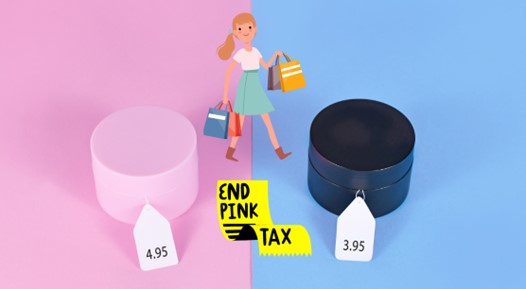What is the Pink Tax?
The Pink Tax is not an actual tax, but hundreds of products and services have been found to have a pink tax. The name is derived from the fact that many of the items are pink in color – as they are intended for women.
Just like Subliminal marketing you will see instances of the Pink Tax being used to boost sales of products and services in subtle and not-so-subtle ways.
For the uninitiated, the Pink Tax is an extra fee that is often charged to women for comparable products and services that are gender-specific, such as razors, shampoo, and clothing. According to a report by the New York City Department of Consumer Affairs, women in America are spending an extra $1,351 per year on what has been dubbed the “pink tax”. So much so that several state and local governments nowadays prohibit gender-based price discrimination.

Recently in the news, CVS Pharmacy– took a stance on the Pink Tax by ensuring fair and equitable pricing for men’s and women’s comparable products. Although commendable, at this time and age it seems overtly unfair to expect women to pay for their comparable products more than men.
Bring in the factor of gender pay gap – where for every dollar men earn, women earn 77 cents the impact of such deceptive pricing is unjust to say the least. This means that women have less disposable income to spend on goods and services. When you factor in the higher cost of living for women, it is clear that the pink tax is a significant financial burden for many women.
It is not uncommon for “girly” or “Pink” products and services to come with a higher price tag than their male-oriented counterparts. Women are paying more simply because they are women. And it’s not just happening in the U.S.—it is somewhat of a global phenomenon.
Although, gender-based pricing is technically illegal under laws like the Equal Credit Opportunity Act and the Civil Rights Act. However, these laws are difficult to enforce and while the pink tax might not be explicitly legal, it’s still very much a reality for women in America and elsewhere.
Origin of the Pink Tax:
The pink tax dates back to the early 1900s, when companies began marketing different products to men and women. This practice is still alive and well today. Think of how many times we’ve seen “for her” or “for him” on similar products except for packaging or color.
We have all noticed that few products or services just seem to cost more when they are marketed to women. Few examples of products or services that commonly sees the ‘Pink Tax’ being levied are –
- Haircuts
- Clothes
- Toys
- Dry Cleaning
- Personal Care Products
- Beauty Products
- Car Repairs
- Home Goods
- Toys
- Shaving Products
- Car Insurance
- Grooming Services
- Children’s Toys and Clothes
- Adult Clothing
- Senior Health Care Items
- Personal Care Products, Etc.
Why Does the Pink Tax Exist?
There are a few different theories about why the pink tax exists. There is no universal answer to this question, as businesses may charge extra for a variety of reasons.
- One possibility is that businesses simply think they can get away with charging women more because we’ve been conditioned to accept that gender-based price hikes are just the way things are.
- Another possibility is that businesses believe that women are willing to pay more for “girly” products because they place a higher value on their appearance than men do.
- They may believe that women are willing to pay more for certain products, especially if they are marketed as being “for women.”
- They may believe that women are less price-sensitive than men, and so they can get away with charging more.
- Others may charge extra because they believe that pink items are more stylish or fashionable, and thus worth the extra cost.
The pink tax is a financial burden for women that often goes unnoticed. When every purchase includes this hidden surcharge, it can add up to thousands of dollars over the course of a year. And because the pink tax is cloaked in secrecy, it is hard to fight against it.

What can be done about the pink tax?
There is no easy answer when it comes to the pink tax. However, there are a few things that can be done in order to help alleviate the financial burden of the pink tax.
- One way to combat the pink tax is to simply by becoming more aware of pricing disparities
-
- While shopping, the prices of related products marketed to both men and women can be compared. By being aware of the pink tax, shoppers can make more informed purchasing decisions and avoid overspending on gender-specific products.
- Another way to fight the pink tax is to support businesses that offer gender-neutral pricing.
-
- There are a growing number of businesses that are marketing their products as gender-neutral or unisex, which means they don’t charge a higher price for items simply because they’re meant for women.
- Another way is to make your voice heard by speaking out against the pink tax at a policy level and calling on businesses to end this discriminatory practice.
What do you think about this? – Do share your thoughts and opinions using the Comment sction!



